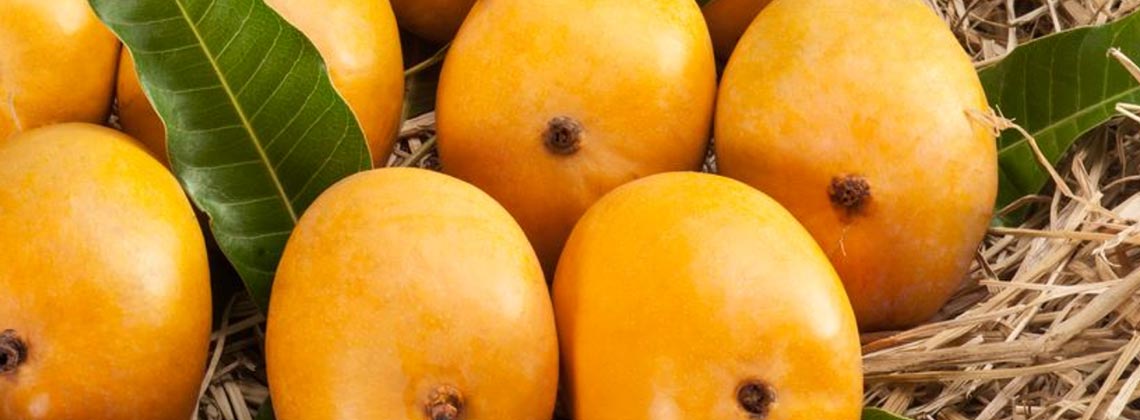In traditional ethno veterinary medicine, all parts of the mango are used to treat abscesses, broken horns, rabid dog bites, stings, heat stroke, miscarriage, bacterial illness, blisters and wounds in the mouth, inflammation of the inner ear, colic, diarrhoea, liver disorders, excessive urination, tetanus, and asthma.
Numerous parts of the mango tree are used in Ayurvedic medicines as an antiseptic, astringent to tone lax tissues, laxative, diuretic, and to increase sweating, promote digestion, and expel parasitic worms or other internal parasites.
Current Ayurvedic practices use various parts of the mango for different ailments.
- For diarrhoea, mango leaves are pounded together and taken with rice water. For nosebleeds, the juice of the mango seed is placed into the nostrils.
- For an enlarged spleen, ripe mango juice is consumed with honey.
- To treat gonorrhoea, mango bark is pounded and added to milk and sugar.
- A variety of the plant’s parts are used as a paste or powder for cleaning the teeth,
- The juice of the mango is considered a restorative tonic, as well as a treatment for heat stroke.
- Mango leaves have powerful antioxidant properties as they have a high content of flavonoids and phenols. The antioxidant and antimicrobial properties of mango leave can help treat various ailments as regulates diabetes, lowers blood pressure, fights restlessness, treats gall and kidney stones, cures respiratory problems, treats dysentery, remedy for ear aches, heals burns, stops hiccups, and good stomach tonic, flushes out toxins from the body and keeps stomach clean.
- The bark is used as an astringent in diphtheria and rheumatism, and the gum was used in dressings for cracked feet and for scabies.
Scientific studies revealed that the macro- and micronutrient composition and bioactive compounds present in Mango contribute to its many health benefits.
- Mango fruits are a rich source of vitamins A, B, B6, B9, C, K, E, folate, riboflavin, thiamine and niacin and good source of minerals like, Potassium, Magnesium, Phosphorus, Calcium, and Iron.
- Mangoes are also a good source of both soluble and insoluble fibre. Soluble fibre can help prevent cardiovascular disease and improve gastrointestinal health.
- Mango is a source of many pharmacologically and medically important chemicals, including mangiferin, mangiferonic acid, hydroxymangiferin, flavonoids, phenolic acids, and carotenes.
- The xanthone mangiferin, found in many different parts, shows promising results in the areas of antitumor, anti-diabetic, and anti-microbial actions.
- Mango also contains smaller amounts of lutein and zeaxanthin, which are important for maintaining eye health and preventing macular degeneration.
- The enzymes like Magneferin, catechol oxidase and lactase are present in mangos that improves digestion.
- The health benefits of the fruit pulp is due to its high concentration of antioxidant nutrients and phytochemicals, such as carotenoids, play an important role in protective health, cardiovascular disease, and macular degeneration, as well as improving immune health.
The polyphenols that have been identified in the mango fruit include gallic acid, gallotannins, quercetin, iso-quercetin, mangiferin, ellagic acid, and beta-glucogallin. These polyphenols have powerful antioxidant activity as well as other potentially therapeutic effects. Gallic acid, for example, is known to have anti-inflammatory and antitumor activities, while ellagic acid has been found to exhibit anti-mutagenic, antiviral, and antitumor effects.
Recent scientific studies indicate that mango possesses myriad therapeutic properties, including anti-diabetic, anti-oxidant, antiviral, cardio tonic, hypotensive, and anti-inflammatory.
A study found that mango stem bark extract showed a powerful scavenging activity of hydroxyl radicals and acted as a chelator of iron. Although iron is an essential mineral, it is toxic in excessive amounts. Iron chelators could be an important approach to lessen iron-induced oxidative damage and prevent iron accumulation in diseases in which accumulation is prevalent, such as hemochromatosis, a metabolic disorder in which the body absorbs too much iron, and thalassemia, a rare, inherited blood disorder caused by a lack of haemoglobin, which results in fewer healthy red blood cells.
This same study found a significant inhibitory effect on the degradation of brain cell membranes in an animal model, and prevented DNA damage caused by some chemotherapy treatments.
Study showed the consumption of freeze-dried mango prevented the increase in fat mass and the percentage of body fat as well as improved glucose tolerance and lowered insulin resistance.
Mango seed kernel has great moisturizing properties and mango seed oil is an excellent source of fatty acids, vitamins and minerals, which are all vital for hair health. Mango kernel oil has recently attracted attention due to its unsaturated fatty acid composition



